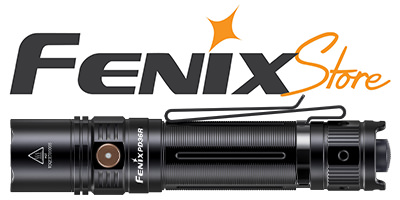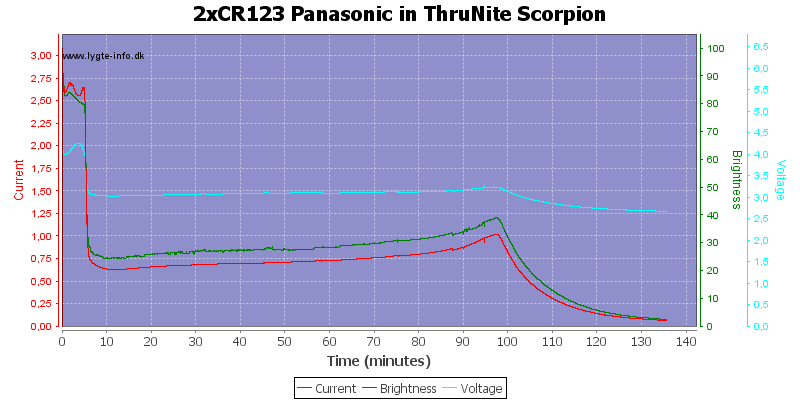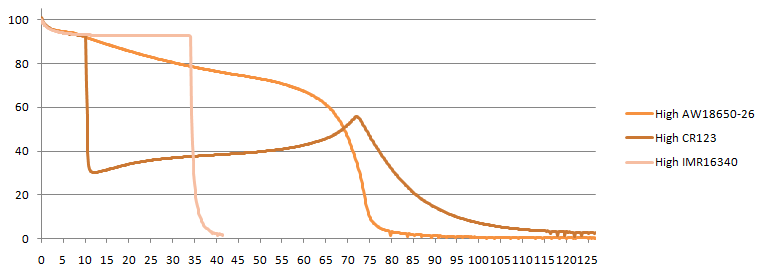UPDATE: Scroll down this thread for a discussion, but the gist of the findings are that the Scorpion V2 is driven high enough on Max to trip the PTC safety circuits of most primary CR123A cells, when run over a sustained period.  Although external cooling helps delay this effect, it is still not something you routinely want to do.
Although external cooling helps delay this effect, it is still not something you routinely want to do.
The second point is that there is a marked difference in the behaviour of made-in-the-USA Duracell/Panasonic cells compared to made-in-China Titanium Innovation cells. The Duracell/Panasonic cells appear to heat up far more quickly than the Titanium Innovations cells in this situation (and thus trip their PTCs earlier). Again, scroll down for a greater discussion, with comparative data from my testing and HKJs.
In some of my high-output lights tested on 4xCR123A, I have noticed an interesting step-down pattern at various points into the run. For example, see the Thrunite Catapult V2 SST-50 and Olight M31 SST-50 runs in this review:
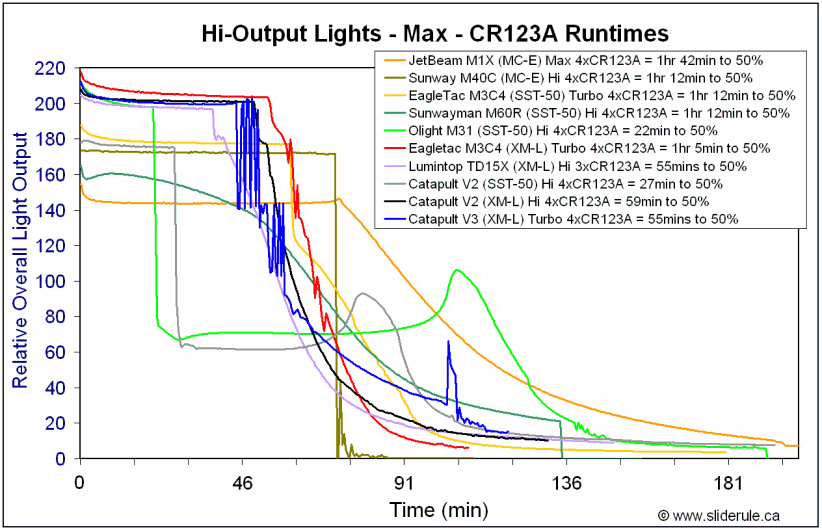
Most lights don't show this behavior, and I always thought it was some sort of thermal shut-down sensor in the circuit in those lights (i.e. responding to increased temperature due to the resistance of CR123As).
It seems the Thrunite Scorpion V2 is showing the same behavior, but it is quite variable depending on the battery brand. I note that this light is not reported as having a thermal sensor.
Here is a comparison in the Scorpion V2 on Max using my standard Titanium Innovations CR123As and Panasonic made-in-USA CR123A, with and without external cooling (i.e. a small fan near the light). Note the Scorpion V2's LED should be driven ~2.5A on max (in its continuously-variable mode).
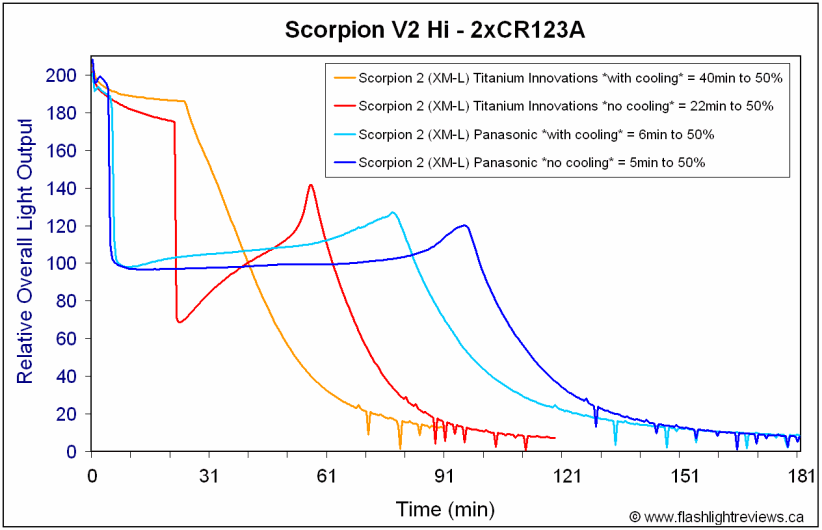
The Titanium Innovation cells perform consistently for a lot longer - with cooling, there was no sign of a step-down (and even without cooling, it only happened near the end of the run).
Cooling also didn't make much of a difference on the Panasonic runs - except I got barely ~5 mins to step down without it, and ~6 mins with it. The only real difference cooling seems to make is in the rate of the recovery phase.
The only real difference cooling seems to make is in the rate of the recovery phase.
So it would appear that the Panasonic cells can't handle the current load and heat up faster than the Titanium Innovations cells (or their PTC circuits kick in faster?). This is turn either triggers some sort of stepdown circuit/resistor, or causes some sort of battery "hiccup".
Thrunite informs me that they use a resistor which varies with temperature, so that when the temperature is high, the resistor will drive the current lower. As the temp drops in the CR123As (i.e. while being driven less hard), output gradually recovers. That makes sense to me on the recovery side, but I don't quite see why the drop-off would be so rapid. :thinking:
Any ideas as to what is going on here? I'm also curious as to the rather large difference between the two brands.
EDIT: I should add that the ambient room temperature rose during the course of the day as I was doing these runtimes, which may be a contributing factor between the brands (although I would think a small one). It was ~22C room temp for the cooled Titanium Innovation cells, ~23C for the uncooled TI cells, ~24C for the uncooled Panasonic, and ~25C for the cooled Pannies.
 Although external cooling helps delay this effect, it is still not something you routinely want to do.
Although external cooling helps delay this effect, it is still not something you routinely want to do. The second point is that there is a marked difference in the behaviour of made-in-the-USA Duracell/Panasonic cells compared to made-in-China Titanium Innovation cells. The Duracell/Panasonic cells appear to heat up far more quickly than the Titanium Innovations cells in this situation (and thus trip their PTCs earlier). Again, scroll down for a greater discussion, with comparative data from my testing and HKJs.
In some of my high-output lights tested on 4xCR123A, I have noticed an interesting step-down pattern at various points into the run. For example, see the Thrunite Catapult V2 SST-50 and Olight M31 SST-50 runs in this review:

Most lights don't show this behavior, and I always thought it was some sort of thermal shut-down sensor in the circuit in those lights (i.e. responding to increased temperature due to the resistance of CR123As).
It seems the Thrunite Scorpion V2 is showing the same behavior, but it is quite variable depending on the battery brand. I note that this light is not reported as having a thermal sensor.
Here is a comparison in the Scorpion V2 on Max using my standard Titanium Innovations CR123As and Panasonic made-in-USA CR123A, with and without external cooling (i.e. a small fan near the light). Note the Scorpion V2's LED should be driven ~2.5A on max (in its continuously-variable mode).

The Titanium Innovation cells perform consistently for a lot longer - with cooling, there was no sign of a step-down (and even without cooling, it only happened near the end of the run).
Cooling also didn't make much of a difference on the Panasonic runs - except I got barely ~5 mins to step down without it, and ~6 mins with it.
 The only real difference cooling seems to make is in the rate of the recovery phase.
The only real difference cooling seems to make is in the rate of the recovery phase.So it would appear that the Panasonic cells can't handle the current load and heat up faster than the Titanium Innovations cells (or their PTC circuits kick in faster?). This is turn either triggers some sort of stepdown circuit/resistor, or causes some sort of battery "hiccup".
Thrunite informs me that they use a resistor which varies with temperature, so that when the temperature is high, the resistor will drive the current lower. As the temp drops in the CR123As (i.e. while being driven less hard), output gradually recovers. That makes sense to me on the recovery side, but I don't quite see why the drop-off would be so rapid. :thinking:
Any ideas as to what is going on here? I'm also curious as to the rather large difference between the two brands.
EDIT: I should add that the ambient room temperature rose during the course of the day as I was doing these runtimes, which may be a contributing factor between the brands (although I would think a small one). It was ~22C room temp for the cooled Titanium Innovation cells, ~23C for the uncooled TI cells, ~24C for the uncooled Panasonic, and ~25C for the cooled Pannies.
Last edited:
